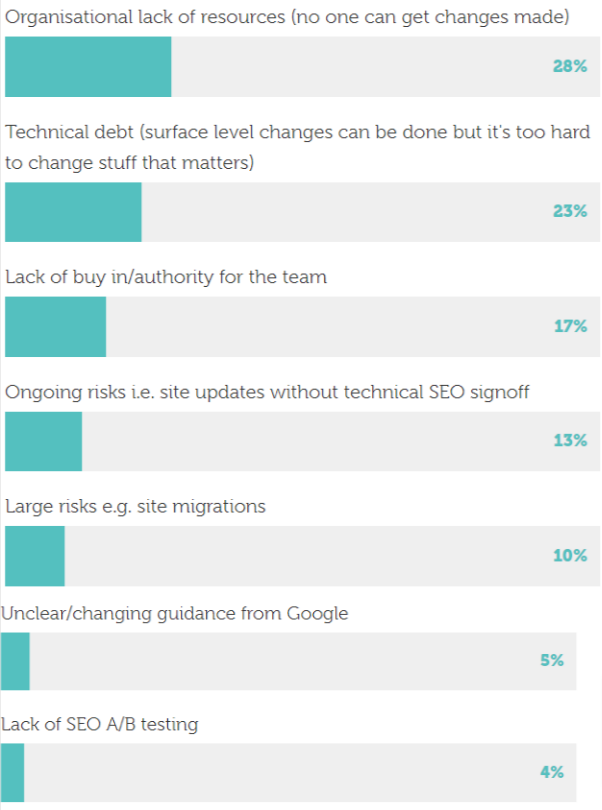In a never-ending debate between the advent and rise of AI-powered tools and search options and the relevance of PPC and SEO in 2023, organizations seem to be at their wits’ ends, wondering about what lies ahead.
In today’s blog, we will discuss the relevance of technical SEO, look into expert opinions based on the findings of The State of Technical SEO Report, and finally discuss how to do a technical SEO audit replete with a handy technical SEO audit checklist.
So without any further ado, let’s work our way up from the basics to the intricacies of what your organization might need to get into to maintain those top ranks on SERPs!
Decoding the Basics of Technical SEO
If you have been pumping a major chunk of your marketing budget into investing in the best content strategists out there and even tried shade bidding, yet nothing seems to reflect in those organic sales numbers, then maybe you need to roll up your sleeves and conduct a technical SEO audit for your website. Let’s begin with understanding what technical SEO means.
Technical SEO ensures your website is compatible & indexable with search engines like Bing or Google. It helps you find and fix any problems that might stop your website from appearing in the search results.
It is a conflation of factors such as site speed, mobile-friendliness, crawlability, indexability, security, and structured data. It is important for online businesses because it helps them achieve higher ranks on SERPs and attract more potential customers.
Some of the things you need to do for technical SEO are:
• Check your website for any SEO-related issues, such as broken links, long titles, pages without meta descriptions, images without alt tags, etc. These issues can affect how search engines rank and display your website. You can deploy tools like Bing Webmaster or Google Search Console to identify and resolve these issues.
• Find out if your website is penalized or not by the search engines. A penalty is a negative action that lowers your website’s ranking or visibility in the search results. Penalties can be caused by violating the search engines’ guidelines, such as using spammy or low-quality content, unnatural links, or deceptive techniques. You can use tools like Bing Penalty Checker or Google Penalty Checker to see if your website has any penalties and how to recover from them.
• Conduct site audits to improve your website’s performance and usability. A site audit comprehensively analyzes your website’s technical aspects, such as speed, security, mobile-friendliness, accessibility, etc. A site audit can help you identify and resolve issues affecting your website’s user experience and SEO. You can use tools like Bing Site Scan or Google Lighthouse to conduct site audits and get recommendations on optimizing your website.
Importance of Conducting Regular Technical SEO Audits in 2023
Now that we are familiar with the meaning of technical SEO let’s delve into the importance it holds.
• Technical SEO increases your website’s crawling rate. Crawling is the process of scanning and analyzing your website’s content and structure by search engines. The more often and faster your website is crawled, the more chances you have to get your pages indexed and ranked in the search results. Technical SEO helps you improve your website’s crawling rate by using techniques such as sitemap, robots.txt, canonical tags, etc.
• Technical SEO helps you avoid or recover from penalties by using techniques such as the disavow tool, noindex tag, 301 redirects, etc.
• Technical SEO helps you improve your user experience by deploying enhanced mobile-friendliness, page speed, HTTPS, structured data, etc.
Takeaways From the Latest Technical SEO Audit Report & Reflecting on Expert Opinions
When asked about the biggest obstacles to technical SEO success, the following insights were offered:
• Lack of resources:
28% of the respondents said this is the biggest risk to technical SEO success. They lack time, money, people, or tools to implement and maintain technical SEO best practices and strategies. For example, they might not have enough developers to fix technical issues or enough budget to invest in new technologies or tools.
• Technical debt:
23% of the respondents said this is the biggest challenge to technical SEO success. This means that they have accumulated a lot of technical problems or errors on their website over time that are difficult or costly to fix. For example, they might have outdated code, broken links, slow pages, or duplicate content that affects their website’s performance and ranking.
• Lack of buy-in/authority:
17% of the respondents said this is the biggest risk to technical SEO success. This means they do not have enough support or influence from their management or stakeholders to prioritize and implement technical SEO initiatives and changes. For example, they might face resistance or indifference from their bosses, clients, or colleagues who do not understand or value the importance of technical SEO.

When they delved deeper into the top three skills that a technical SEO professional should have, interestingly, a good content strategy figured in the top three list.
- Data Analysis ~ 72%
- Content strategy ~ 39%
- Reading & understanding HTML/CSS ~ 58%
Step By Step Guide To Conducting a Technical SEO Audit For Your Website
Presenting a ready-to-go step-by-step technical SEO audit checklist that can come in handy when you sit with your SEO team in the coming quarter to fix those chinks in the armor. Feel free to bookmark this blog for easy reference!
Here are some steps on how to conduct a technical SEO audit:
• Step 1: Crawl your website.
It would be best to use a tool that can scan and analyze your website’s content and structure, such as Screaming Frog, SEMrush, or Ahrefs. These tools can help you find and fix any issues that might prevent search engines from crawling and indexing your website.
• Step 2: Spot and fix crawlability and indexability issues.
Some common issues that affect crawlability and indexability are broken links, duplicate content, canonical tags, robots.txt, sitemap, no index tags, redirects, etc. You need to ensure that your website has no issues that might prevent search engines from finding and displaying your pages in the search results.
• Step 3: Review your site’s mobile-friendliness.
Mobile-friendliness is how well your website adapts and responds to different screen sizes and devices. Mobile-friendliness is important for SEO because search engines prefer websites that offer a memorable user experience on mobile devices. You can use tools like Bing Mobile Friendliness Test or Google Mobile-Friendly Test to check how mobile-friendly your website is and get suggestions for improving it.
• Step 4: Check your site’s speed.
Speed is important for SEO because search engines favor websites that are quick to load and provide a smooth user experience. You can use tools like Bing PageSpeed Insights or Google PageSpeed Insights to measure your site’s speed and get recommendations on optimizing it. You should also pay attention to the Core Web Vitals, which refer to a set of parameters that measure the quality of the user experience on your website.
• Step 5: Check your site’s security.
Security is important for SEO because search engines favor safe and trustworthy websites. You can use tools like Bing Site Scan or Google Lighthouse to check your site’s security and get suggestions for improving it. You should also ensure that your website uses HTTPS.
• Step 6: Check your site’s structured data.
Structured data is a way of formatting and organizing the information on your website so that search engines can better understand and display it in the search results. Structured data can help you enhance your site’s appearance and visibility on search engines by adding features like rich snippets, breadcrumbs, knowledge panels, etc. You can use tools like Bing Markup Validator or Google Structured Data Testing Tool to check your site’s structured data and get suggestions for improving it.
Conclusion
A technical SEO audit can help you enhance your site’s usability, speed, security, crawlability, indexability, structured data, and more. We hope that the insights shared in this blog will help you identify and resolve any technical issues affecting your site’s performance and visibility on search engines. If you’d prefer to have experts look into it, we recommend investing in Mavlers’ full-suite SEO services.


Naina Sandhir - Content Writer
Latest posts by Naina Sandhir - Content Writer (see all)
Ecommerce Marketing Automation Hacks for This Holiday Season
The Designer’s Comprehensive Guide To The Top UI/UX Designs in 2023